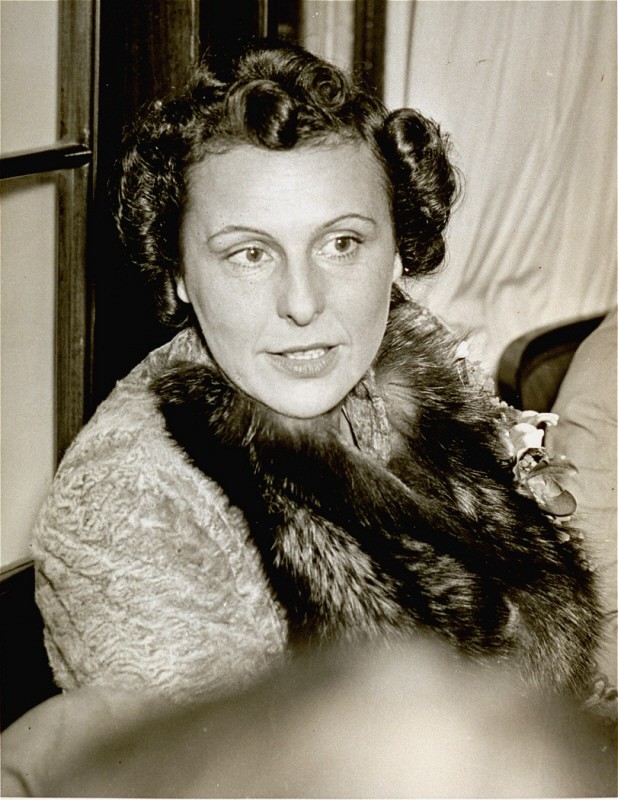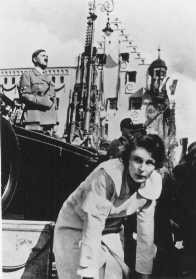Leni Riefenstahl
Leni Riefenstahl (Helene Riefenstahl) was a German dancer, actress, and film director best known for her imposing propaganda films in support of the National Socialist (Nazi) Party.
Early Life and Career

Born in Berlin on August 22, 1902, Riefenstahl began her long and extraordinary career as an interpretive dancer. After a knee injury temporarily halted her vocation, Riefenstahl became fascinated with the possibilities of the medium of film, especially nature films. She became the star of a number of German director Arnold Fanck's silent motion pictures, typically set in the Alps (so-called Bergfilme), in which the young Riefenstahl figured as the athletic and daring female lead.
Popular as an actress with German audiences in the silent era, Riefenstahl directed her first major feature film, Das blaue Licht (The Blue Light), in 1932. The film was well received, and more importantly attracted the attention of a rising politician who prided himself on having artistic ambitions, Adolf Hitler. In the same year, Riefenstahl had heard Hitler speak at a public rally and was riveted by his oratorical style and his ability to mesmerize audiences.
Propaganda for the Nazi Party

Hitler saw Leni Riefenstahl as a director who could use aesthetics to produce an image of a strong Germany imbued with Wagnerian motifs of power and beauty. In 1933, he asked Riefenstahl to direct a short film, Der Sieg des Glaubens (The Victory of Faith), shot at that year's Nuremberg Nazi Party Rally. The film was a template for her more famous work, Triumph des Willens (Triumph of the Will), shot at the Nuremberg Rally the following year, in 1934. Riefenstahl initially rebuffed Hitler's commission for the film, but relented when she received unlimited resources and full artistic license for the picture. Triumph of the Will, with its evocative images and innovative film technique, ranked as an epic work of documentary film-making, and is widely regarded as one of the most masterful propaganda films ever produced. It won several awards, but forever linked the film's subject, National Socialism, with its artist, Riefenstahl.
Equally stunning were Riefenstahl's directorial efforts in Olympia, which captured with haunting effectiveness the images of the 1936 Summer Olympic Games in Berlin. It was for Olympia that Riefenstahl pioneered numerous cinematographic techniques, such as filming footage with cameras mounted on rails (commonly known today as tracking shots). Olympia's forceful blend of aesthetics, sports, and propaganda again won Riefenstahl accolades and awards, including Best Foreign Film honors at the Venice Film Festival and a special award from the International Olympic Committee (IOC) for depicting the joy of sport.
World War II
By her own account, the advent of World War II and the rapid escalation of violence under the Nazi regime had an unfavorable effect on both Riefenstahl and her career. Early in the Polish campaign, an incident seemed to have shaken Riefenstahl's confidence in the movement she had glorified in cinematic images. While accompanying German troops near Konskie, the filmmaker witnessed the execution of Polish civilians shot in retaliation for a partisan attack on German troops. Riefenstahl apparently left her filming that day in order to make a personal appeal to Hitler against such arbitrary violence. The incident may have planted a seed of doubt in Riefenstahl's mind, but it did not prevent her from filming Hitler's triumphal parade into Warsaw just weeks later.
After World War II
After the war Riefenstahl attempted to separate herself from the criminal nature of the Nazi regime, suggesting her duty was to her craft and not necessarily to the Nazi authorities who commissioned her films. In what she and others would later claim was an effort to eschew further propaganda efforts, Riefenstahl had begun filming Tiefland (Lowlands) in 1940. A story set in the Spanish Pyrenees, Tiefland was a project that she had earlier shelved when persuaded by a determined Hitler to undertake Triumph of the Will. Shot on location near Kitzbühl, Austria, the filming dragged out over nearly four years. In order to enhance the story's “gypsy” flavor, Riefenstahl aides arranged to “borrow” some 51 young Roma prisoners from the nearby labor camp at Maxglan-Leopoldskron as extras. For the indoor scenes, filmed in Berlin-Babelsberg in 1942, Riefenstahl used as extras at least 66 Roma and Sinti inmates, virtually all males, from the Berlin-Marzahn camp for Gypsies. Allegations that the German Criminal Police returned the Roma, after fulfilling their “obligation,” to the Maxglan and Marzahn Gypsy camps (Zigeunerlager) and later deported them to their deaths at Auschwitz, were serious enough to involve Riefenstahl in a civil suit. That suit was dropped in 2002 only after her production company retracted a public statement Riefenstahl had made in which she claimed that all of the extras had survived the war. Tiefland premiered in 1954, eight years after French authorities occupying the Tyrol arrested Riefenstahl and confiscated her film materials, in January 1946.
In the postwar years, Leni Riefenstahl was the subject of four denazification proceedings, which finally declared her a Nazi sympathizer (Mitläufer). Although never a member of the Nazi Party, Riefenstahl found it difficult to overcome her association with the propaganda films she had made during the early Nazi period, and encountered difficulties in regaining her position in the German cinematic community. Her experience was quite unlike that of her colleague Veit Harlan, who had directed such seminal Nazi propaganda works as Jüd Süss and Kolberg, but who returned to a flourishing directorial career in the 1950s. Riefenstahl turned to still photography, publishing in the 1970s an illustrated volume on the primitive Nuba tribe of the Sudan; in her late seventies, she undertook a new interest in underwater cinematography.
Throughout her long career Leni Riefenstahl achieved a new aesthetics in film and introduced groundbreaking cinematic techniques, but she could never escape her past association as a Nazi propagandist and remained a controversial figure until the end of her life. She died of cancer in Pocking, Germany, on September 8, 2003, a few weeks after her 101st birthday.
Critical Thinking Questions
Consider if artists are responsible for ideologies and beliefs portrayed or supported in their works. How would Riefenstahl answer?
Watch Olympia or Triumph of the Will and note how messages are delivered by the director’s choices.
Propaganda films can be very powerful. How can citizens in any country learn to view films responsibly?

